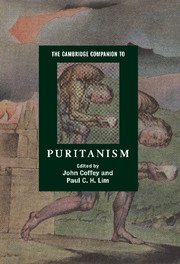20 - The historiography of Puritanism
from Part IV: - Puritanism and posterity
Published online by Cambridge University Press: 28 November 2008
Summary
To review the historiography of Puritanism is to review the history of early modern England. The history of Puritanism started almost at the same moment as the emergence of Puritanism as a movement and a sensibility. The first history of the Elizabethan Puritan movement was published by Richard Bancroft in 1593. Thereafter histories of Puritanism came thick and fast as both the enemies of the godly and the godly themselves strove to produce accounts of a 'Puritan' or 'sectarian' threat against which they could define their own position as the personification of the Protestant tradition or national church. During and after the English Civil War such efforts intensified. Peter Heylin wrote a history, if not of Puritanism, then of presbyterianism, and both his and John Hacket's biographies of Laud and Williams respectively were organised in part at least around different versions of the Puritan threat and how best to deal with it. Samuel Clarke's famous collections of Puritan lives - the first version of which was published in the early 1650s, to be reissued at the Restoration and again and again thereafter - can be read as replies to these and other attempts to cast 'Puritanism' as a threat to order. From the outset, then, histories of Puritanism were heavily ideological interventions in debates about the nature of the English church, Protestant orthodoxy and ecclesiastical, political and social order. The historiography of Puritanism from Bancroft or Hacket to Collinson, from Edwardes to Hill or Hughes, from Heylin to Tyacke is, therefore, the story of how various versions of the Church of England and its others have been used to define the discourse (and indeed to shape the practice and patronage networks) of the national church over the five hundred years since the Reformation.
- Type
- Chapter
- Information
- The Cambridge Companion to Puritanism , pp. 346 - 372Publisher: Cambridge University PressPrint publication year: 2008
- 6
- Cited by



